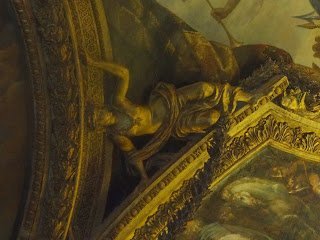

The moment we saw the majestic gates of the Palace of Versailles, we knew that a treasure awaited us for the rest of the day. Twenty kilometres away from Paris, in Versailles, this is the place where the French Royals resided for about a hundred years from late seventeenth century to late eighteenth century. What was, once upon a time, a simple hunting lodge turned out to be the seat of power of France. The Palace has been a notable witness to some of the biggest events in world history for almost five hundred years. Within the Palace is engraved the pride associated with the glory of victory in wars. Also embedded are the principles of benefits of peace. With more than sixty thousand art works illustrating five centuries of French History, this palace is indeed a marvel and a UNESCO world heritage site.

The French Royals... kings starting from Louis XIV till Louis VI and the queens from Maria Theresa till Marie Antoinette, who stayed in this Palace kept adding new sections to the Palace. The Hall of Mirrors, the Hall of Battles, the War and Peace Salons, the Royal Opera, the Royal residences, the Chapels and the gardens with numerous fountains and canals and the Grand and Petite Trianon are among the attractions which are to be seen to be believed. The Kings and the Queens who stayed here redefined luxury to a different level. But History is never uniform. Came the days when the French Revolution pulled down the extravagance of the Palace to the extent that monarchy couldn't return to the Palace again. Not even Napoleon Bonaparte could make this Palace his residence, as the cost of renovation was considered too high for the time and the prevalent situation.

Post the revolution, subsequent Monarchs, especially King Louis Phillipe commenced the renovation activity and added new sections including the Museum which was dedicated to house the glories of France. But he too didn't stay in the Palace.

Some turbulent years of wars witnessed important artifacts melted down to finance the wars that followed and the Palace began to lose its sheen. However, times improved and serious restoration efforts commenced during late nineteenth century only to continue till early twenty first century, with the world wars slowing down the momentum in between. In 1978, a major terrorist bombing caused heavy damages to the Palace including the loss of invaluable art and damage to the Palace. Luckily the Hall of Mirrors, the Opera House and the Chapels had escaped unhurt.

The Palace in general and the Hall of Mirrors in particular have been witness to some really significant events. The Hall of Mirrors, the main ceremonial reception room, is undoubtedly the most famous location in the Palace. The Hall is seventy three meters in length and its whole length is dedicated to political, cultural, economic and artistic glory of France. The Treaty of Versailles, which formally ended the first world war was signed in the Hall of Mirrors. Fifty years before the Treaty of Versailles was signed, the proclamation of the German Empire also happened in the exactly same location. The eighteenth century Peace of Paris treaty, which granted recognition to the independence of the United States also was signed in this very location.

Getting a feel of the Palace can take days. Understanding different elements that are inside this Palace can possibly take months...if not years. After all, this is no ordinary palace. This is the Palace of the Versailles....Europe's largest Chateau and is a dream to be experienced. A visit to Paris remains incomplete without a day trip to the Palace of Versailles.
The link to the official video of the Palace.



Comments
Post a Comment